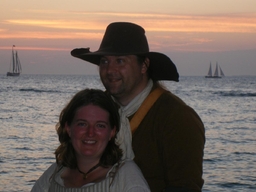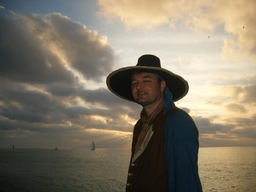-
Posts
587 -
Joined
-
Last visited
Content Type
Profiles
Forums
Events
Gallery
Everything posted by MarkG
-
This is a 1660s dandy. He is wearing petticoat breaches. His doublet is straight - early doublets were shorter with tabs along the bottom. Note the oversized shirt that has been pulled out enough to hang below the doublet. Most of the details have been exaggerated to make fun of the dandies of the time. Mark
-
Being on the crew for one of the big guns - I love burning that much of someone else's powder and not having to clean it afterward. Seeing some wild dolphins off the west beach. Stealing Mission's mug during the auction. Mark
-
I was impressed with your work but I would like to know why you are using wire bands instead of lugs to join the barrel to the stock? Mark
-
I'll expect to be riding and camping with them again. Not sure about my wife. Mark
-
Try sitting for 25 hours. Mark
-
If you want to be cruel, you hand flint, steel, and charcloth to visitors and tell them to start a fire. Mark
-
The Spanish silver ingots recovered from the wreck of the Atocha that are in the Mell Fisher Museum in Key West are about the size and shape of loaves of Italian bread, and about 80 pounds each. They have various assay stampings on them on the flat side. They are the color of lead, rather than being shiney, from long immersion in the sea. I suspect they were fairly shiney when new. >>>> Cascabel See here for a picture. The bars were rough cast, probably into a depression in sand giving them that bread loaf shape. Then they were weighed. If they were too heavy then a piece was cut off with a chisel. Finally, they were stamped with a royal seal to indicate that they had been weighed. I heard a talk by one of the divers. He was disappointed by the "treasure chests." The chests used in the Atocha were just planks nailed together with the minimum number of nails to hold it together. Mark
-
Is there still time to order a couple of shirts for PiP?
-
Final tally - the Santa Maria auction brought in $300.00. The first auction brought in around $600.00. Then were were the bar fund raisers that Micky organized, the donation that the bar gave us. The year's two biggest weekends were the two pirate events. All told, piracy has been very good for the Santa Maria. Mark
-
It wasn't me. The pirates forced me at pistol point, threatening me by snapping their pistols at my head. It was Photoshopped. I just did that for exercise and to learn how to fire guns. Nah, it wasn't me. You are off the hook. You were firing the swivel gun as one of the people defending the Santa Maria from the pirates who wanted to turn it into a pirate ship. When you climbed over the rail, no hostilities were taking place. Mark
-
Technically they were tools that were being used as weapons. Since they were improvised weapons, either the pirate would also improvise something to hold it or they would just stick it in their sash. I've done that. It works fairly well. The axe doesn't need to be razor sharp to be a deadly weapon or a usable axe. Sashes also work for holding belaying pins. Mark
-
If you bring a gun, don't forget cleaning supplies. Mark
-
I thought that things like that went out in the 14th century. It makes me wonder if this is actually a longer piece that was cut down for some reason or a version of a thundermug (signaling device). Or maybe a chamber from a swivel gun? Mark
-
This looks pretty consistent with earlier ones. No pockets. Smaller cuffs than landsmen wear so that the sleeves don't get caught on things. I've heard that sailor's fashions changed more slowly than other trades. Notice that his tricorn is "backwards". I've seen this before on sailors. Mark
-

That "X" of cord on the side of a tricorn
MarkG replied to Ivan Henry aka Moose's topic in Captain Twill
Just to confuse things, cocked hats sometimes used a hook on the hat brim and an eye on the crown of the hat. If you look carefully at mid-to-late 17th century hats you will see this. That doesn't help a bit with your pipe. -
I can make a strong case that matchlocks are much safer to prime first. One of the most common accident with a matchlock is not noticing a hot coal lurking in the priming pan (I've seen it happen to two experienced musketeers). If that happens, the last thing that you want is a charge in the barrel. Mark
-
I agree with you there Cascabel, it is dangerous to load a primed weapon. We make it our practice to load the barrel and then prime the piece. Well, here I'll disagree with you, gentlemen. I've been following military drill with both my matchlock and my Bess for 25 years. When priming from the cartridge on the Bess, you are never sure if you have left enough powder in the cartridge to properly prime. With the matchlock, handling powder in one hand and lit match in the other, cleaning and priming the pan first, before casting about makes much more sense. The way I figure it, the people who used these things for real knew what they were doing and why. I'm happy to follow the original manuals of arms. Hawkyns I"m with Hawkyns on this. Loading and priming is fine if you are hunting and have all the time in the world but it is ungainly when using a cartridge in a battle. I had someone at the last PiP explain how he loads first, making sure to save enough powder for the prime. If he has too much for the prime then the remaining amount goes down the barrel. This negates the advantage of loading first. Even using a cartridge and priming flask slows things down and adds steps. The more steps the longer it takes to load and the more likely you will get rushed and do something wrong. Also, if you do it right, you have the muzzle pointed up at something like a 60 degree angle so that even if it goes off, it will not hit anyone. You should also be keeping your hand away from the muzzle. Add in a hammerstall and loading military style should be perfectly safe. Mark
-
I think that a sleeved, short waistcoat was common among sailors from late in the 17th century well into the 18th century. You can see this in several period pictures including the ones of Anne Bonny and Mary Read dressed as men (with cleavage). The one of Blackbeard wearing a thrum cap might also be a sleeved waistcoat. All it takes is once in a boat in a longer waistcoat and you see why they wore shorter ones.
-
The problem with shooting from a horn is that a spark can set the whole thing off. The chargers in a bandoleer (the term apostles is 20th century) have one charge each, the same as a cartridge so they are at least as safe as cartridges. I think that the rules allow loading from a measuring tube and these should count the same. Personally, I think that they are safer. I'v seen priming flasks blow without setting off the bandoleer. If a charge should go off while you are loading, you have a good chance of the flash being directed away from your hand by the charger. I don't expect much protection from some newsprint. Mark
-
Not at all. They predate the Buccaneer period by decades. The main difference is the lock. It would not be my first choice for land battles since it has a shorter range than a musket. Mark
-
You need to make a field trip to Jamestown and check out their ships. The Godspeed is about your size. The Dove at Saint Mary's CIty is a bit smaller but well outfitted. Mark
-
Most of that safety equipment is required - things like life jackets, distress signals, and an anchor. I have a big duffel with these that I always throw in my boat. I usually point this out and ask if anyone wants to wear a lifejacket (my wife often does). For a small boat, I consider a paddle and/or oars important. For a larger boat, you need a motor. Either way, you have to have some means of maneuvering if you get into trouble. Not that I count as anything more than a beginner, also. Mark




